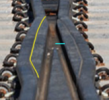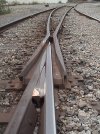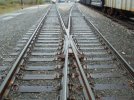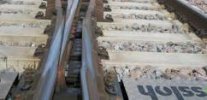Looking at NMRA standard S-1:
I notice that as the wheel transitions from the closure rail to the frog via the wing rail, that as it crosses the gap the effective wheel radius decreases because the edge of the wing rail is further from the flange and thus on a smaller radius of the wheel surface. This could lead a slight drooping of the wheel and thus a distinct "bump" as the thicker part of the wheel makes contact with the frog.
I see two ways of compensating for this:
I notice that as the wheel transitions from the closure rail to the frog via the wing rail, that as it crosses the gap the effective wheel radius decreases because the edge of the wing rail is further from the flange and thus on a smaller radius of the wheel surface. This could lead a slight drooping of the wheel and thus a distinct "bump" as the thicker part of the wheel makes contact with the frog.
I see two ways of compensating for this:
- roll off the point of the frog slightly so the incoming wheel can roll up a slope rather than contact the point. You will still get a "dip" but not a "strike".
- gradually and slightly increase the height of the wing rail as it diverges from the opposite closure rail / frog rail so as to compensate for the shape of the wheel surface.






